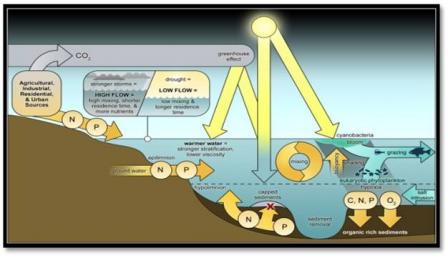Causes and Prevention
What are some causes of cyanobacterial blooms?
-
light availability
-
water temperature
-
alteration of water flow
-
vertical mixing
-
pH changes
-
nutrient loading (both nitrogen and phosphorus)
-
trace metals
As a result of the interplay of these factors, there may be large temporal fluctuations in the levels of cyanobacteria and their toxins in predominating species that occur largely on seasonal time scales. Specifically, the ratio of nitrogen to phosphorus, organic matter availability, temperature, and light attenuation, likely play an interactive role in determining corresponding HAB composition and toxin production.
How do human activities affect cyanobacterial blooms?
There is widespread agreement within the scientific community that the incidence of HABs is increasing both in the U.S. and worldwide. This recent increase in the occurrence of HABs has been attributed to increasing anthropogenic activities and their interaction with factors known to contribute to the growth of cyanobacterial blooms. Point sources (which may include discharges from sewage treatment plants and confined animal feeding operations) and non-point sources (which may include diffuse runoff from agricultural fields, roads and stormwater), may be high in nitrogen and phosphorus and can promote or cause excessive fertilization (eutrophication) of both flowing and non-flowing waters.
How will global climate change affect cyanobacterial blooms?
Anthropogenic climate change has recently been identified as a contributing factor to cyanobacterial blooms by altering many environmental conditions that may promote the growth and dominance of HABs. These conditions include:
- Warmer water temperatures
- Changes in salinity
- Increases in atmospheric carbon dioxide concentrations
- Changes in rainfall patterns
- Intensifying of coastal upwelling
- Sea level rise

For more information on the effect of climate change on the occurrence of HABs, please visit the EPA's Climate Change and Harmful Algal Blooms Fact Sheet (PDF). (3 pp, 172 K, About PDF)
The following conceptual figure illustrates the environmental processes that control cyanobacterial blooms, including man-made management actions and impacts of climate change.
What measures can be taken to prevent cyanobacterial blooms?
Preventative measures are the preferred approach to managing the occurrence of cyanobacterial blooms. The most effective preventative measures are those that seek to control anthropogenic influences that promote blooms such as the leaching and runoff of excess nutrients. Management practices for nutrients, specifically nitrogen and phosphorus, should have the goal of reducing loadings from both point and nonpoint sources, including water treatment discharges, agricultural runoff, and stormwater runoff. Devices that result in the mixing of lakes (for example, by air bubbling), enhance vertical mixing of the phytoplankton, which minimizes the formation of surface blooms of buoyant cyanobacteria. Also, increasing the water flow through lakes or estuaries reduces water residence time and inhibits cyanobacteria blooms; however, these efforts can be expensive and are best suited to small affected water bodies.
More Information
US EPA Climate Change and Harmful Algal Blooms Fact Sheet
US EPA Climate Change Indicators in the United States
US EPA Watershed Framework Approach
US EPA Watershed Analysis and Management (WAM) Guide for States and Communities
US EPA OW Nutrient Pollution Video
For comments, feedback or additional information, please contact Lesley D'Anglada (Danglada.Lesley@epa.gov), Project Manager, at 202-566-1125.
